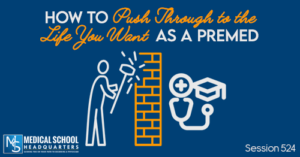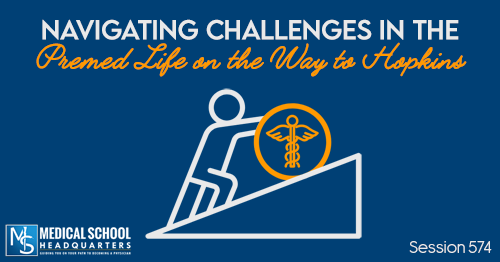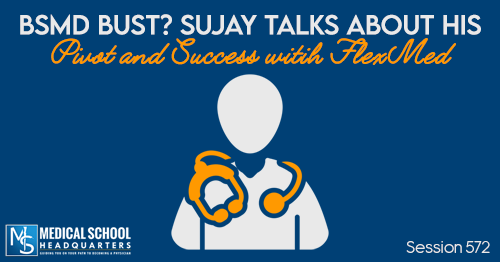Apple Podcasts | Google Podcasts
Session 524
Jennifer Ledbetter joins us today as she shares her story, a stereotypical nontraditional journey of someone who realized she wanted to be a doctor at 27 years old. Find out how she pushed through naysayers and navigated her way into medical school acceptance.
For more podcast resources to help you with your medical school journey and beyond, check out Meded Media.
Listen to this podcast episode with the player above, or keep reading for the highlights and takeaway points.
[00:41] The MCAT Minute
The MCAT Minute is brought to you by Blueprint MCAT.
Blueprint MCAT created its first immersive MCAT course. It’s a one-month highly intensive MCAT course and they’re doing it again this summer because it worked so well during the winter. Check out Blueprint MCAT and see what they can do for you this summer to get you the score you need to get into the school that you deserve.
[02:06] Interest in Becoming a Physician
From Finance to Fitness: Jennifer’s Career Path
Jennifer had been working in fitness for some time. She often referred to her job as being in “health and wellness” to make it sound more sophisticated. Jennifer found herself further intrigued by her clients’ physiology and motivation every day. The fact that she was able to assist a family member in losing a significant amount of weight just through exercise motivated her even more. She knew that health management was the path she wanted to pursue. However, Jennifer was also aware that she was about to turn 28, and the thought of starting something new at that age terrified her.
Jennifer’s professional background wasn’t always in fitness. She had an undergraduate degree in finance and a Master’s in Accounting and had originally set her sights on working on Wall Street. However, she ultimately found herself in corporate accounting, which didn’t quite fit with her passions.
A Personal Connection to Health Management: Jennifer’s Aunt’s Diagnosis
While working in accounting, her aunt was diagnosed with type two diabetes, and Jennifer moved back home to help her and managed to lower her aunt’s A1C levels. This was Jennifer’s first introduction to managing someone’s health, and it sparked her interest in health management.
'If I didn't do something, I would really regret it if something happened later.'Click To TweetOvercoming Fear to Pursue a Meaningful Career
Jennifer had always had a love for exercise and staying active, having been an athlete in high school and having participated in triathlons. However, while working in finance and accounting, she was left feeling unfulfilled and unhappy with her career. There was also an underlying trauma that had affected Jennifer and her family deeply. Her grandmother had passed away suddenly at the age of 62, which had been traumatic for everyone, and Jennifer’s aunt had helped raise her in the absence of her mother who had her at a young age. So, when her aunt was diagnosed with a chronic illness,
Jennifer knew she couldn’t stand by and do nothing. She felt compelled to pursue a career in health management. She did not want to have any more young family members taken away due to preventable illnesses.
[07:09] The Fear of Pursuing a New Career Path
Jennifer recalls the initial thought of wanting to pursue a medical career as being quite daunting. She felt scared of even speaking it out loud to her then-boyfriend, who she was discussing a future with. The idea of committing to such a demanding and unfamiliar industry was overwhelming.
Lack of Familiarity with the Medical Industry
Jennifer mentions that she had very little knowledge of the industry when she first considered making the switch to a medical career. Her parents were not in the medical field, and this lack of connection meant that she had to learn everything from scratch.
Researching and Exploring Career Options
Despite the initial fear and the lack of familiarity, Jennifer spent a considerable amount of time researching and exploring the possibility of pursuing a medical career. She wanted to be sure that it was the right choice for her before committing.
The Support of Her Partner
Jennifer’s then-boyfriend and current husband was supportive throughout her journey of exploring and eventually pursuing a medical career. His encouragement and understanding were integral to Jennifer’s success, as she felt confident with his support behind her.
Initial Resistance from Family
When Jennifer first told her mother that she wanted to pursue a career in medicine, her mother’s first concern was about Jennifer’s potential to miss out on important life events. One of them is having children. Although Jennifer’s mother’s comments could be perceived as unsupportive, Jennifer clarifies that she understands and respects her mother’s perspective. Jennifer felt that her life priorities were different from what her mother expected for her. While her brother was settled down with a family in Louisiana, Jennifer felt that pursuing a medical career was the path she wanted to take, even if it meant potentially delaying starting a family.
[12:49] When is the Right Time to Have Kids in Medical School
Jennifer recognized that everyone’s journey is unique, and while starting a family may be a priority for some, it was not a priority for her at the moment. She had to remind herself that it was okay to have different goals and that living in California gave her the flexibility to explore different paths.
Navigating Parenthood While Pursuing a Demanding Career
Ultimately, Jennifer understood the importance of following one’s passion, regardless of outside pressures or expectations. She knew that pursuing a medical career was the right path for her, and she was willing to take the necessary steps to achieve her goal.
Jennifer wants to clarify that although she and her husband do plan on having children, they are still figuring out the best time for it.
The decision to pursue a career in medicine and start a family can be a difficult one for women, who are often faced with societal pressure and expectations.
Different Paths to Parenthood
Jennifer notes that there is no right time or path when it comes to having children while pursuing a medical career. She has seen students who have children before medical school, during medical school, and during residency. Parenthood is inherently challenging, and the right path looks different for everyone.
Jennifer and her husband made the decision to wait until after residency to have children. They wanted to ensure that Jennifer could fully focus on her education and training without the added stress of parenthood. It was a decision that worked for their family, but they acknowledge that it may not be the right choice for everyone.
Jennifer emphasizes that while the decision to have children and pursue a demanding career may be challenging, it can also be incredibly rewarding. It is essential to figure out where one wants to place the hardships in their life and to embrace the challenges that come with parenthood and a career in medicine.
'There is not one right path, one right time to have a kid. Having a kid is hard... end of story. And so, you just figure out where you want that hardness in your life.'Click To Tweet[15:00] Navigating Premed Resources
Jennifer initially majored in math and was unsure if she could handle the demands of a medical career. However, she started doing her research by Googling prerequisites and found free resources online to guide her.
She looked into various options like extension programs and community colleges to complete the prerequisite courses. Ultimately, she decided on a DIY post-bac program to avoid starting medical school with debt.
Jennifer found that the advising services provided by postbac programs were subpar, and it was challenging to grasp how long the application cycle was. She had to rely on her own research and take matters into her own hands.
Jennifer created a spreadsheet to understand how her life would look financially in different career paths. She recognized that as she got older, she had to take into account the cost of putting herself in debt and working for less time. She was willing to go to medical school as long as the breakeven point was achieved.
[20:59] Her DIY Postbac Experience
Jennifer did not want to take all the classes that were offered through the formal postbac program and preferred a DIY approach. She had already taken a few courses at Santa Monica College before deciding to pursue a medical career. However, she faced difficulties finding a higher-level course and had to take it at another institution.
Jennifer found it challenging to communicate her needs with advisors at different institutions. She felt that they did not understand what she was trying to achieve and had to navigate through the process on her own.
Jennifer completed 18 courses at Santa Monica College for only $3,300 and three courses at UCLA Extension for $7-800 apiece, bringing her total investments under $5,000. She acknowledges the benefits of community college education but also highlights that it may not necessarily lead to acceptance into medical school.
Jennifer acknowledges that it is challenging to determine which path will lead to medical school acceptance and that she applied to 20 programs. Despite being accepted, she is unsure if pursuing a community college route might have hurt her chances.
[23:29] Learning How to Study Again
Jennifer took introductory courses in biology, chemistry, and physics to build a strong foundation for medical school. Although this meant it took longer for her to apply, she wanted to make sure she was well-prepared for the MCAT. She found the introductory courses to be challenging as she had been out of school for a while. She compared it to going back to high school, and the language of chemistry felt like a foreign language to her.
Jennifer had spent 27 years of her life not knowing what she wanted to do but found it liberating when she finally figured out her path. However, she also had to learn how to study again and stay motivated throughout the coursework.
'I spent 27 years of my life not really knowing what I wanted to do. And when I figured out what I wanted to do, it was just so liberating.'Click To TweetDespite the challenges, building a strong foundation was crucial for Jennifer’s success in medical school. She believes that it was worth the extra time and effort to ensure she was well-prepared for the rigorous coursework ahead.
[26:08] Building the Rest of the Application
Difficulties with COVID-19
COVID-19 made it challenging for Jennifer to figure out what steps she needed to take to get into medical school. However, she found help from online platforms like Reddit, despite acknowledging that some users can be neurotic.
Jennifer credits Reddit for helping her understand the competitiveness of medical school admissions, which she initially did not fully grasp. She realized that having good grades and a high MCAT score were not enough, and there were other factors to consider.
Purpose of Extra-curricular Activities
Jennifer realized that extra-curricular activities were not just for checking boxes in her application. It allowed her to understand what she would be getting into for the next 10 years. Despite providing minimal value as a volunteer in the ER during COVID-19, she found the experience stressful and eye-opening.
She also spent a lot of time researching online to figure out the steps she needed to take to get into medical school. Using Google and reading extensively online helped her figure out what she needed to do and was a significant part of her first six months of preparation.
[28:28] Submitting the Application
Jennifer initially planned to apply to medical school in 2021, having completed all of her prerequisites except for physics and biochemistry. She aimed to study for the MCAT from mid-June to the end of July and apply in August as the deadline for applications was in October.
Realizing the Need for More Time
She realized that this plan was unrealistic, particularly as she had not yet taken biochemistry, which was crucial for the MCAT. She spent days attempting to understand metabolic pathways and suffered a breakdown, ultimately realizing that she needed more time to prepare. It was challenging to come to terms with this change in plans, but Jennifer found it to be a breath of fresh air.
Jennifer viewed the additional time as an opportunity to build a stronger application. It enabled her to gain more clinical experience and shadowing hours and take on a volunteer role in the ER. This not only made her application stronger but also helped her gain a better understanding of the medical profession.
Despite the challenges she faced, Jennifer remained committed to achieving her goal of attending medical school. She overcame obstacles, such as needing more time to prepare for the MCAT, and used it as an opportunity to build a better foundation for her future studies.
'That fear of failure... is what drives a lot of decisions. Unfortunately... so much of the fear and anxiety around the application process.'Click To TweetOvercoming Obstacles as a Premed
As a premed, it’s easy to feel overwhelmed by everything you need to do, but there’s really not much that has the potential to be a make-or-break moment. However, that all changes when you begin to work on your application.
It’s the point where you realize whether this is where you’ll be accepted into medical school or not. It’s an understandable mentality, but also a misplaced one, as one application cycle is not the only opportunity you have to become a doctor.
It’s just a chance to get into med school or not, and you can try again next time. Delaying Jennifer’s application was a good decision, considering rolling admissions and all of that.
[34:05] Her First Interview Invite
Jennifer didn’t have research on her primary application, but when an opportunity to do glioblastoma research at UCLA presented itself, she couldn’t say no. She knew that even with her improved application, she still had no idea if she would be accepted into medical school. Soon after her arrival at UCLA, she received an interview invitation and was ecstatic. When a second interview invitation arrived shortly thereafter, she knew that the first one was not a fluke.
Interview Day
Jennifer received multiple interview invitations and was thrilled to have made it to this stage of the application process. She was eager to showcase her passion for medicine and demonstrate her potential as a physician.
Her non-traditional status did come up in interviews, but Jennifer was prepared to address these questions and explain her motivation for pursuing a career in medicine. The interview process was challenging, but it allowed her to connect with medical professionals who shared her passion for helping others.
[37:14] Importance of Family Support in Medical School
Jennifer knows that having a strong support system in medical school is crucial. However, she didn’t find this information by browsing school websites, but rather by speaking with current or former med students. She utilized her network on social media and in the fitness industry to connect with individuals who had attended the schools she was considering.
By doing so, she learned about the importance of family support and flexibility. One example she shares is a conversation with an LSU New Orleans graduate who took time off before returning to medical school and was welcomed back with open arms. This type of support was especially important for Jennifer and her husband, who plan on having children in the future.
[40:11] Building a Community of Support for Non-Traditional Pre-Meds
Jennifer has connected with several women who have reached out to her about balancing medical school with family planning. She acknowledges that men also want to start families, but recognizes the unique challenges faced by women who carry and give birth to children.
She found a friend and like-minded individual through social media platforms. This relationship allowed her to share questions, advice and provide support while navigating the application process.
'I just want people to understand they don't have to be 27 in a career that they don't like and do that for the rest of their life. It is possible.'Click To TweetJennifer understands how challenging it can be for nontraditional premeds to feel isolated as they often don’t have friends going through the same journey, especially during a pandemic. This inspired her to create her platform, not just for aspiring medical professionals, but for anyone seeking support to transition into a new career or life path.
Jennifer believes that starting medical school can be one of the more challenging routes due to the length of time and commitment required. However, it’s important to her to show others that it is possible to pursue your passions and make a change at any stage of your life. Through her platform and community, Jennifer aims to inspire others and provide an environment of support where people can connect, share and grow together.
[42:32] Final Words of Wisdom
Jennifer believes it’s crucial to gain clinical experience as early as possible. She suggests that aspiring medical professionals start by seeking out opportunities that don’t require training or certification. For her, her first clinical job involved volunteering at a hospice as a companionship volunteer. She applied online and completed a background check, which allowed her to visit nursing homes and participate in house calls.
Jennifer notes that gaining early clinical experience isn’t just crucial for med school applications, but also for personal growth as well.
For non-traditional students who have never worked in a healthcare setting, she emphasizes the importance of understanding that it’s not the same as what you see on TV shows like Grey’s Anatomy. Gaining practical experience and working with real patients is essential to know if this is the right career path for you, and early exposure can give you more time to explore and identify your passions.












